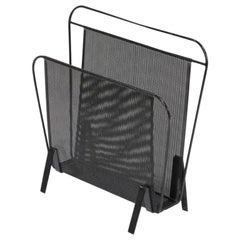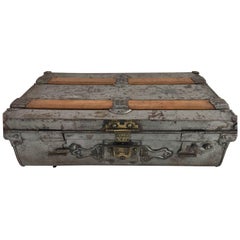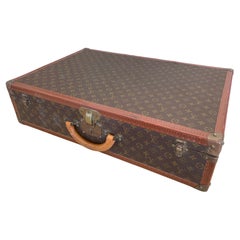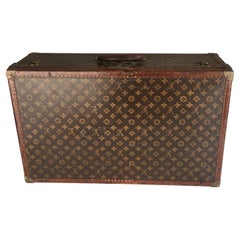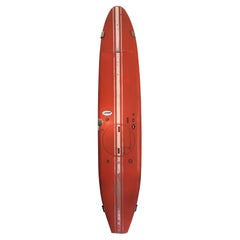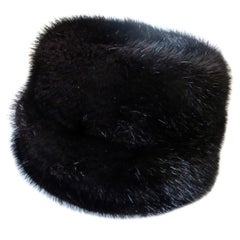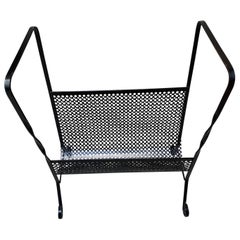Objet d'art Alexandre Ferucci More Furniture and Collectibles
to
6
11
11
2
11
1
8
2
1
2
9
4
4
3
2
6
4
4
3
2
11
11
11
2
2
Mathieu Mategot Magazine Rack
Located in Los Angeles, CA
Magazine rack by the famous Mathieu Mategot. Enameled and perforated metal, the common signature style of Mategot. Very collectable piece.
Category
Mid-20th Century French Mid-Century Modern Magazine Racks and Stands
Materials
Metal
"The Big Nude" Large Sumo Book by Helmut Newton
By Helmut Newton
Located in Los Angeles, CA
"The Big Nude" Large Sumo Book with stand by Helmut Newton. Brand new in it's original packaging, unopened and unexposed. Bound printed paper, signed and ...
Category
1990s German Magazine Racks and Stands
Materials
Chrome
$14,400 Sale Price
20% Off
1930s Metal Suitcase
Located in Los Angeles, CA
Most unique and unusual 1930s metal suitcase by Jones Brothers & Co. combination of wood and metal with unique hardware.
Category
Mid-20th Century American Trunks and Luggage
Materials
Metal
$1,250
Louis Vuitton Suitcase
By Louis Vuitton
Located in Los Angeles, CA
Louis Vuitton Suitcase in great vintage condition. France, 1940s.
Category
Mid-20th Century French Trunks and Luggage
Materials
Brass
$4,000
Louis Vuitton Vintage Suitcase
By Louis Vuitton
Located in Los Angeles, CA
Vintage suitcase by Louis Vuitton, in great vintage condition. France 1940s.
Category
Vintage 1940s French Trunks and Luggage
Materials
Brass
Aluminum Jetboard by Sargent Fletcher Co.
Located in Los Angeles, CA
Jetboard motorized aluminum surfboard by Jetboard by Sergent Fletcher Co.,
USA, 1965-68. Painted aluminum with steel wall mounting brackets.
Category
Mid-20th Century American Mid-Century Modern Sports Equipment and Memora...
Materials
Aluminum
$6,200 Sale Price
50% Off
"The Big Nude" Sumo Book by Helmut Newton
By Helmut Newton
Located in Los Angeles, CA
"The Big Nude" sumo book with stand by Helmut Newton. Bound printed paper, signed and numbered to interior 'Helmut Newton'. This book is number 9,908 of 10,0...
Category
1990s German Magazine Racks and Stands
Materials
Chrome
$8,400 Sale Price
20% Off
Umbrella Stand
Located in Los Angeles, CA
Very rare and exquisite umbrella stand, 1950s. Metal and brass, the base is 1 inch thick glass and 10 inch diameter. Width at the top is 11 inches. Total height is 22 inches.
Category
Mid-20th Century Italian Umbrella Stands
Materials
Brass
$2,240 Sale Price
34% Off
Set of Eight Vintage Luggage
Located in Los Angeles, CA
Beautiful set of eight (8) vintage luggage in various materials:
Qty one (1): 1930s metal suitcase by Jones Brothers & Co. combination of wood and metal with unique hardware. Dimensions: Height 8 in. (20.32 cm), width 24 in. (60.96 cm), depth 15 in. (38.1 cm)
Qty one (1): alligator skin suitcase, 1940s. Dimensions: Height 8 in. (20.32 cm), width 18.5 in. (46.99 cm), depth 14.5 in. (36.83 cm)
Set of Five Drew & Son Picadilly (Mortar) Pigskin luggage...
Category
Early 20th Century American Trunks and Luggage
Materials
Metal
$4,400 Sale Price / set
20% Off
Set of Pigskin Luggage, 1950s
Located in Los Angeles, CA
Most unique set of Drew & Son Picadilly (Mortar) Pigskin luggage, 1950s. Ralph Lauren's favorite luggage.
Dimensions:
30" L X 18.5" D X 12" H
30" L X ...
Category
Mid-20th Century American Trunks and Luggage
Materials
Leather
$3,200 Sale Price / set
23% Off
1940s Alligator Skin Suitcase
Located in Los Angeles, CA
Very unique and highly collectible alligator skin suitcase, 1940s.
Category
Mid-20th Century More Furniture and Collectibles
Related Items
Lady's Vintage Black Mink Hat by I. Magnin & Co. Circa 1965
By I. Magnin
Located in Incline Village, NV
Well made black mink hat designed and sold by I. Magnin & Company in the mid 1960's. The style, undoubtedly worn and made popular by Julie Christie in t...
Category
Vintage 1960s American Mid-Century Modern Hat Racks and Stands
Materials
Fur
Mathieu Matégot 'in the style of', Magazine / Vinyl Rack, Circa 1975
By Mathieu Matégot
Located in Saint ouen, FR
Mathieu Matégot (in the style of), Magazine / vinyl rack, Circa 1975.
Perforated metal and wrought iron
Measures: L 38 x H 50 x D 26 cm.
Category
Vintage 1970s European Other Magazine Racks and Stands
Materials
Metal, Wrought Iron
$348
H 19.69 in W 14.97 in D 10.24 in
David Hockney, A Bigger Book
By David Hockney
Located in Los Angeles, CA
Hardcover, 50 x 70 cm (19.6 x 27.5 in.), 498 pages, 13 fold-outs, with an adjustable bookstand designed by Marc Newson, plus an illustrated 680-page chronology book
A Bigger Book, TASCHEN’s SUMO...
Category
21st Century and Contemporary European Books
Materials
Paper
Custom Made Lucite Oversized Coffee-table Book Stand for Taschen Sumos
By Iconic Design Gallery
Located in Miami, FL
Custom Made Lucite Oversized coffee-table book stand for Taschen Sumos
This large, free-standing lucite book stand allows you to display and view oversized specialty books as seen a...
Category
21st Century and Contemporary American Modern Magazine Racks and Stands
Materials
Brass
$2,400 / item
H 36 in W 30.5 in D 18.75 in
20th Century Louis Vuitton Suitcase In Natural Cow Hide, France c.1910
By Louis Vuitton
Located in Royal Tunbridge Wells, Kent
A highly unusual and exceptionally rare Louis Vuitton suitcase, originating from the early years of the 20th century, distinguishes itself not with the globally renowned monogram canvas but with a distinctive covering crafted from a singular piece of cowhide. This unique piece represents a special order from Louis Vuitton, showcasing the brand's historical commitment to utilising only the finest hides available.
Unlike many of its counterparts, leather trunks and cases of this era often struggle to withstand the test of time, requiring regular treatments to prevent drying and disintegration. Remarkably, this particular example defies the odds, retaining the same supple quality it possessed on the day it first graced the shop floor. This suitcase belongs to Louis Vuitton's collection of "speciality materials," which encompasses a diverse range, including, but not limited to, zinc, copper, crocodile leather, and cow leather.
A brief history about Louis Vuitton trunks: Louis Vuitton was born in 1821 to a farmer and milliner and came from a long-established working-class family in eastern France. Vuitton grew up understanding the effects of perseverance and a strong work ethic from watching his family. At the age of 16, he made the decision to walk 292 miles from his hometown to Paris to try and make a new life for himself. When he arrived the city was in the midst of industrialization with current modes of transportation evolving quickly allowing for longer journeys. With this came the need for sturdy travel pieces.
Vuitton was taken as an apprentice for a successful box maker and packer named Monsieur Marechal. He learned to craft durable containers and how to pack them properly – a well-respected profession at the time.In 1854, years after he had mastered his craft and became well respected for it, Vuitton ventured out on his own to open a shop on Rue Neuve des Capucines. It was here that he began to establish himself as a luggage maker. Then, in 1858, Vuitton designed the first Louis Vuitton steamer trunk. At the time trunks had rounded tops to allow for water to run off but this did not allow for convenient stowage. Vuitton introduced a flat, yet waterproof, trunk that was easily stackable. The first of his trunks were outfitted with a grey canvas referred to as Trianon – it wouldn’t be until several decades later that the signature monogram would be introduced.
With a burgeoning business, Vuitton moved his family and workplace to Asniere, where he employed twenty workers to craft his trunks. By 1900 he would have 100 employees, and in 1914 the company would more than double in size. After years of success, Vuitton began to experiment with the design of his luggage by introducing a new striped canvas pattern (1876) and later the still well-known Damier print (1888). The hand-painted patterns were developed to prevent counterfeits. Even in the late 1800s, Louis Vuitton was enough of a status symbol to warrant counterfeiting. In 1886, his son George invented and patented an ingenious locking system that made it impossible to pick the lock of their trunks. This lock is still used today.
1892 would prove to be a time of mourning for the family as Louis Vuitton passed...
Category
20th Century French Other Trunks and Luggage
Materials
Brass
$4,424
H 6.7 in W 25.99 in D 16.93 in
Sebastião Salgado "GENESIS" Signed, Limited Edition SUMO Book, with stand
By Sebastião Salgado
Located in Los Angeles, CA
Collector's Edition Book measures: 18.4 x 27.6 in.
Total weight: 130 lb.
The Collector’s Edition is limited to 2,500 copies (No. 501-3,000), numbered and signed by Sebastião Salg...
Category
21st Century and Contemporary Italian Books
Materials
Cherry, Paper
$4,500 / item
H 27.6 in W 18.4 in D 8 in
Americano Single-Ended, Stereo Amp by Toolshed Amps for Original in Berlin
By Original in Berlin
Located in Berlin, DE
Americano single-ended, Stereo Pentode Amplifier
5 watts per channel
Input sensitivity: 1.03v to full output
Input impedance: 50K
Inputs: 2, switchable by Front Panel Mounted Carling Switch
Output: 8 Ohm Via 5-Way Binding Posts
Bias: No user adjustment necessary
Tube compliment: 6973 power tubes (X2) Other compatible power tubes as follows: 6CM6/6CZ5/6EM5 (Performance Varies), EZ81/6CA4 Rectifier Tube (X1), EF91/6AM6 Driver Tubes (X2) Other compatible driver tubes as follows: M8083/CV4015 (Performance Varies).
Original in Berlin...
Category
21st Century and Contemporary American American Craftsman Music Stands
Materials
Copper
$5,944
H 7.09 in W 8.47 in D 12.6 in
Vintage Safe Deposit Box, Czechoslovakia 1930s
Located in Zohor, SK
Beautiful vintage safe-deposit box in a great functional condition. The box was created in 1930s in Czechoslovakia and works like brand new. Original key...
Category
Vintage 1930s Slovak Mid-Century Modern Trunks and Luggage
Materials
Steel
Ettienne Aigner Hard Suitcase
Located in Tarrytown, NY
Ettienne Aigner hard suitcase.
Category
Early 2000s Trunks and Luggage
Materials
Canvas, Blown Glass
20th Century Louis Vuitton Suitcase Alzer 80, 1970
By Louis Vuitton
Located in Epfach, DE
909481 Alzer 80 80 cm x 26 cm 52.5 cm with removable tray
Louis Vuitton suitcase, Alzer 80 with removable tray, in wonderful, well-kept condition with origin...
Category
20th Century French Trunks and Luggage
Materials
Leather
Helmut Newton, Baby Sumo, Limited Edition
By TASCHEN, Helmut Newton, Philippe Starck
Located in Los Angeles, CA
BABY SUMO, welcome to the world!
The legendary Helmut Newton SUMO in a spectacular new edition
The Helmut Newton SUMO was overwhelming in every respect: a ...
Category
Late 20th Century Books
Materials
Stainless Steel
Mathieu Mategot Style Magazine Holder Rack Black Metal France
By Mathieu Matégot
Located in Lège Cap Ferret, FR
Handsome Mathieu Matégot-style modernist magazine holder or rack. A striking example of a French 1950s metalwork design.
Folded, perforated black metal.
Can also be used as a side ...
Category
Mid-20th Century French Mid-Century Modern Magazine Racks and Stands
Materials
Metal
